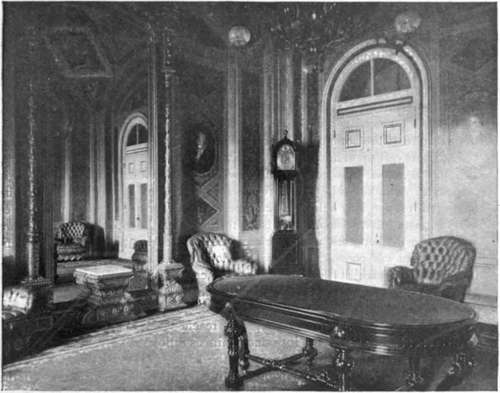President's Room
Description
This section is from the book "The National Capitol. Its Architecture Art And History", by George C. Hazelton, Jr. Also available from Amazon: The National Capitol Its Architecture Art and History.
President's Room
At the west end of the private lobby, which is directly north of the Senate Chamber proper, is a room known as the President's room. This is, beyond doubt, the most beautifully decorated room in the Capitol. Whenever occasion requires the presence of the President of the United States at the Capitol, this room is solely for his use. Except during the administrations of Cleveland, it has been customary for the Executive to visit the Capitol during the last days of each Congress to sign bills; and in this room many bills have become laws by the President's approval. It has been the scene of other incidents in their lives. On the evening of March 3, 1865, Grant received a message from. Lee asking for a meeting and interchange of views looking to a submission of " the subjects of controversy between the belligerents to a convention." "General Grant, not being vested with any authority whatever to treat for peace," writes General Horace Porter, " at once telegraphed the contents of the communication to the Secretary of War, and asked for instructions. The dispatch was submitted to Mr. Lincoln at the Capitol, where he had gone, according to the usual custom at the closing hours of the session of Congress, in order to act promptly upon the bills presented to him. He consulted with the Secretaries of State and War, and then wrote with his own hand a reply, dated midnight, which was signed by Stanton, and forwarded to General Grant. It was received the morning of the 4th, and read as follows : 'The President directs me to say to you that he wishes you to have no conference with General Lee, unless it be for the capitulation of General Lee's army, or on some minor and purely military matter. He instructs me to say that you are not to decide, discuss, or confer upon any political question. Such questions the President holds in his own hands, and will submit them to no military conferences or conventions. Meantime you are to press to the utmost your military advantages.' " When the Senate is not in session and the room is not occupied by the President, it is open to public view. The rich decorations are the work of Brumidi. In the northeast corner of the ceiling is a picture of William Brewster, Elder of Plymouth Colony; in the southeast corner, one of Christopher Columbus; and in the southwest corner, one of Benjamin Franklin. The remaining figure is of Americus Vespucius. Four groups also beautify the ceiling. To the north is Religion; to the east, Executive Authority: to the south, Liberty; and to the west, Legislation. All these are in fresco. On the upper portion of the south wall is noticeable a portrait of Washington in oils, which was painted from Rembrandt Peale's celebrated picture, masks and other sources. Around the room are portraits in oils of the first Cabinet, Jefferson, Hamilton, Knox, Randolph and Osgood. The rich furniture of the room is upholstered in red leather; and in one corner stands a handsome "grandfather's clock" of mahogany, purchased in 1887.

The president's room.
Continue to:
